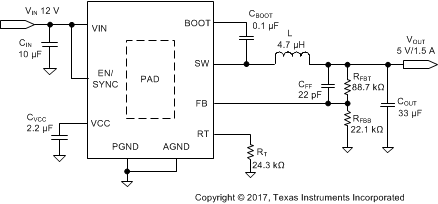SNVSAS5 March 2018 LMR23615-Q1
PRODUCTION DATA.
- 1 Features
- 2 Applications
- 3 Description
- 4 Revision History
- 5 Pin Configuration and Functions
- 6 Specifications
-
7 Detailed Description
- 7.1 Overview
- 7.2 Functional Block Diagram
- 7.3
Feature Description
- 7.3.1 Fixed-Frequency Peak-Current-Mode Control
- 7.3.2 Adjustable Frequency
- 7.3.3 Adjustable Output Voltage
- 7.3.4 EN/SYNC
- 7.3.5 VCC, UVLO
- 7.3.6 Minimum ON-time, Minimum OFF-time and Frequency Foldback at Dropout Conditions
- 7.3.7 Internal Compensation and CFF
- 7.3.8 Bootstrap Voltage (BOOT)
- 7.3.9 Overcurrent and Short-Circuit Protection
- 7.3.10 Thermal Shutdown
- 7.4 Device Functional Modes
-
8 Application and Implementation
- 8.1 Application Information
- 8.2
Typical Applications
- 8.2.1 Design Requirements
- 8.2.2
Detailed Design Procedure
- 8.2.2.1 Custom Design With WEBENCH® Tools
- 8.2.2.2 Output Voltage Setpoint
- 8.2.2.3 Switching Frequency
- 8.2.2.4 Inductor Selection
- 8.2.2.5 Output Capacitor Selection
- 8.2.2.6 Feed-Forward Capacitor
- 8.2.2.7 Input Capacitor Selection
- 8.2.2.8 Bootstrap Capacitor Selection
- 8.2.2.9 VCC Capacitor Selection
- 8.2.2.10 Undervoltage Lockout Setpoint
- 8.2.3 Application Curves
- 9 Power Supply Recommendations
- 10Layout
- 11Device and Documentation Support
- 12Mechanical, Packaging, and Orderable Information
Package Options
Mechanical Data (Package|Pins)
- DRR|12
Thermal pad, mechanical data (Package|Pins)
- DRR|12
Orderable Information
8.2 Typical Applications
The LMR23615-Q1 only requires a few external components to convert from a wide voltage range supply to a fixed output voltage. Figure 22 shows a basic schematic.
 Figure 22. Application Circuit
Figure 22. Application CircuitThe external components have to fulfill the needs of the application, but also the stability criteria of the device's control loop. Table 2 can be used to simplify the output filter component selection.
Table 2. L, COUT, and CFF Typical Values
| fSW (kHz) | VOUT (V) | L (µH) (1) | COUT (µF)(2) | CFF (pF)(3) | RFBT (kΩ)(4)(5) |
|---|---|---|---|---|---|
| 200 | 3.3 | 22 | 200 | 220 | 51 |
| 5 | 33 | 150 | 120 | 88.7 | |
| 12 | 56 | 68 | See note(3) | 243 | |
| 24 | 56 | 33 | See note(3) | 510 | |
| 400 | 3.3 | 10 | 120 | 100 | 51 |
| 5 | 15 | 90 | 68 | 88.7 | |
| 12 | 33 | 47 | See note(3) | 243 | |
| 24 | 33 | 22 | See note (3) | 510 | |
| 1000 | 3.3 | 4.7 | 68 | 47 | 51 |
| 5 | 5.6 | 47 | 22 | 88.7 | |
| 12 | 10 | 33 | See note(3) | 243 | |
| 2200 | 3.3 | 2.2 | 33 | 22 | 51 |
| 5 | 3.3 | 22 | 15 | 88.7 |
(1) Inductance value is calculated based on VIN = 36 V.
(2) All the COUT values are after derating. Add more when using ceramic capacitors.
(3) High ESR COUT will give enough phase boost and CFF not needed.
(4) RFBT = 0 Ω for VOUT = 1 V. RFBB = 22.1 kΩ for all other VOUT setting.
(5) For designs with RFBT other than recommended value, adjust CFF such that (CFF × RFBT) is unchanged and adjust RFBB such that (RFBT / RFBB) is unchanged.